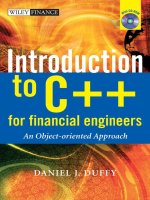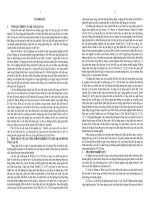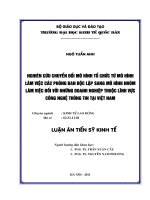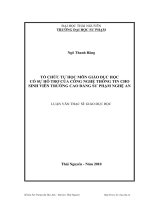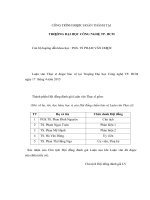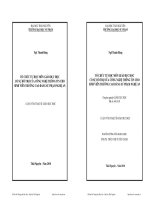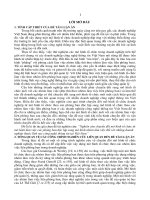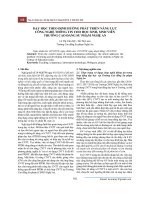Introduction to c++ for financial engineers an object oriented approach
Bạn đang xem bản rút gọn của tài liệu. Xem và tải ngay bản đầy đủ của tài liệu tại đây (4.31 MB, 441 trang )
JWBK114-FM JWBK114-Duffy August 29, 2006 17:22 Char Count= 0
Introduction to C++ for
Financial Engineers
An object-oriented approach
Daniel J. Duffy
iii
JWBK114-FM JWBK114-Duffy August 29, 2006 17:22 Char Count= 0
Introduction to C++ for
Financial Engineers
i
JWBK114-FM JWBK114-Duffy August 29, 2006 17:22 Char Count= 0
For other titles in the Wiley Finance Series
please see www.wiley.com/finance
ii
JWBK114-FM JWBK114-Duffy August 29, 2006 17:22 Char Count= 0
Introduction to C++ for
Financial Engineers
An object-oriented approach
Daniel J. Duffy
iii
JWBK114-FM JWBK114-Duffy August 29, 2006 17:22 Char Count= 0
Copyright
C
2006 Daniel J Duffy
Published by John Wiley & Sons Ltd, The Atrium, Southern Gate, Chichester,
West Sussex PO19 8SQ, England
Telephone (+44) 1243 779777
Email (for orders and customer service enquiries):
Visit our Home Page on www.wiley.com
All Rights Reserved. No part of this publication may be reproduced, stored in a retrieval system
or transmitted in any form or by any means, electronic, mechanical, photocopying, recording,
scanning or otherwise, except under the terms of the Copyright, Designs and Patents Act 1988
or under the terms of a licence issued by the Copyright Licensing Agency Ltd, 90 Tottenham
Court Road, London W1T 4LP, UK, without the permission in writing of the Publisher.
Requests to the Publisher should be addressed to the Permissions Department, John Wiley &
Sons Ltd, The Atrium, Southern Gate, Chichester, West Sussex PO19 8SQ, England, or emailed
to , or faxed to (+44) 1243 770620.
Designations used by companies to distinguish their products are often claimed as trademarks. All brand
names and product names used in this book are trade names, service marks, trademarks or registered
trademarks of their respective owners. The Publisher is not associated with any product or vendor
mentioned in this book.
This publication is designed to provide accurate and authoritative information in regard to
the subject matter covered. It is sold on the understanding that the Publisher is not engaged
in rendering professional services. If professional advice or other expert assistance is
required, the services of a competent professional should be sought.
Other Wiley Editorial Offices
John Wiley & Sons Inc., 111 River Street, Hoboken, NJ 07030, USA
Jossey-Bass, 989 Market Street, San Francisco, CA 94103-1741, USA
Wiley-VCH Verlag GmbH, Boschstr. 12, D-69469 Weinheim, Germany
John Wiley & Sons Australia Ltd, 42 McDougall Street, Milton, Queensland 4064, Australia
John Wiley & Sons (Asia) Pte Ltd, 2 Clementi Loop #02-01, Jin Xing Distripark, Singapore 129809
John Wiley & Sons Canada Ltd, 6045 Freemont Blvd, Mississauga, ONT, L5R 4J3, Canada
Wiley also publishes its books in a variety of electronic formats. Some content that appears
in print may not be available in electronic books.
Library of Congress Cataloging-in-Publication Data
Duffy, Daniel J.
Introduction to C++ for financial engineers : an object-oriented approach / Daniel J Duffy.
p. cm.—(Wiley finance series)
Includes bibliographical references and index.
ISBN-13: 978-0-470-01538-4 (cloth: alk. paper)
ISBN-10: 0-470-01538-1 (cloth : alk. paper)
1. Financial engineering—Computer programs. 2. C++ (Computer program
language) I. Title.
HG176.7.D843 2006
005.13
3024332—dc22 2006020622
British Library Cataloguing in Publication Data
A catalogue record for this book is available from the British Library
ISBN 13 978-0-470-01538-4 (HB)
ISBN 10 0-470-01538-1 (HB)
Typeset in 10/12pt Times by TechBooks, New Delhi, India
Printed and bound in Great Britain by Antony Rowe Ltd, Chippenham, Wiltshire
This book is printed on acid-free paper responsibly manufactured from sustainable forestry
in which at least two trees are planted for each one used for paper production.
iv
JWBK114-FM JWBK114-Duffy August 29, 2006 17:22 Char Count= 0
Contents
0 Goals of this Book and Global Overview 1
0.1 What is this book? 1
0.2 Why has this book been written? 1
0.3 For whom is this book intended? 2
0.4 Why should I read this book? 2
0.5 The structure of this book 2
0.6 What this book does not cover 2
0.7 More information and support 3
PART I C++ ESSENTIAL SKILLS 5
1 Introduction to C++ and Quantitative Finance 7
1.1 Introduction and objectives 7
1.2 A short history of C++ 7
1.3 C++, a multi-paradigm language 8
1.3.1 Object-oriented paradigm 8
1.3.2 Generic programming 10
1.3.3 Procedural, modular and functional programming 11
1.4 C++ and quantitative finance: what’s the relationship? 11
1.5 What is software quality? 11
1.6 Summary and conclusions 13
1.7 Exercises 14
2 The Mechanics of C++: from Source Code to a Running Program 15
2.1 Introduction and objectives 15
2.2 The compilation process 15
2.3 Header files and source files 16
2.4 Creating classes and using their objects 19
2.5 Template classes and template functions 22
2.6 Kinds of errors 25
2.6.1 Compiler errors 25
2.6.2 Linker errors 26
2.6.3 Run-time errors 26
2.7 The struct concept 27
v
JWBK114-FM JWBK114-Duffy August 29, 2006 17:22 Char Count= 0
vi Contents
2.8 Useful data conversion routines 27
2.9 Summary and conclusions 29
2.10 Exercises and projects 29
3C++ Fundamentals and My First Option Class 31
3.1 Introduction and objectives 31
3.2 Class == member data + member functions 32
3.3 The header file (function prototypes) 33
3.4 The class body (code file) 35
3.5 Using the class 38
3.6 Examining the class in detail 40
3.6.1 Accessibility issues 40
3.6.2 Using standard libraries 40
3.6.3 The scope resolution operator ‘::’ 41
3.6.4 Virtual destructor: better safe than sorry 41
3.7 Other paradigms 41
3.8 Summary and conclusions 45
3.9 Questions, exercises and projects 45
4 Creating Robust Classes 49
4.1 Introduction and objectives 49
4.2 Call by reference and call by value 49
4.3 Constant objects everywhere 52
4.3.1 Read-only (const) member functions 52
4.4 Constructors in detail 54
4.4.1 Member initialisation 55
4.5 Static member data and static member functions 55
4.6 Function overloading 57
4.7 Non-member functions 58
4.8 Performance tips and guidelines 58
4.8.1 The ‘inline’ keyword 58
4.8.2 Anonymous objects in function code 59
4.8.3 Loop optimisation 60
4.9 Summary and conclusions 60
4.10 Questions, exercises and projects 60
5 Operator Overloading in C++ 63
5.1 Introduction and objectives 63
5.2 What is operator overloading and what are the possibilities? 63
5.3 Why use operator overloading? The advantages 65
5.4 Operator overloading: the steps 68
5.4.1 A special case: the assignment operator 70
5.5 Using operator overloading for simple I/O 71
5.6 Friend functions in general 72
5.6.1 Friend classes 73
5.7 Summary and conclusions 74
5.8 Exercise 74
Appendix: useful data structures in C++ 75
JWBK114-FM JWBK114-Duffy August 29, 2006 17:22 Char Count= 0
Contents vii
6 Memory Management in C++ 79
6.1 Introduction and objectives 79
6.2 Single objects and arrays of objects on the stack 79
6.3 Special operators: ‘new’ and ‘delete’82
6.3.1 Single objects 82
6.3.2 Arrays of objects 83
6.4 Small application: working with complex numbers 84
6.5 Creating an array class 86
6.5.1 Memory allocation and deallocation 86
6.5.2 Accessing functions 87
6.5.3 Examples 88
6.5.4 The full header file 88
6.6 Summary and conclusions 89
6.7 Exercises 89
6.8 Review questions and comments 91
7 Functions, Namespaces and Introduction to Inheritance 93
7.1 Introduction and objectives 93
7.2 Functions and function pointers 93
7.2.1 Functions in financial engineering 94
7.2.2 Function categories 94
7.2.3 Modelling functions in C++ 95
7.2.4 Application areas for function pointers, part I 96
7.3 An introduction to namespaces in C++ 96
7.3.1 Some extra functionality 97
7.4 An introduction to the inheritance mechanism in C++ 99
7.4.1 Basic inheritance structure 99
7.4.2 Adding new functionality 101
7.4.3 Overriding functionality: polymorphic and
non-polymorphic behaviour 102
7.5 Multiple inheritance 104
7.6 Solution of nonlinear equations 104
7.7 Nonlinear solvers in C++: design and implementation 106
7.8 Applying nonlinear solvers: calculating volatility 108
7.9 Summary and conclusions 109
7.10 Exercises and projects 109
8 Advanced Inheritance and Payoff Class Hierarchies 113
8.1 Introduction and objectives 113
8.2 The virtual specifier and memory deallocation 113
8.3 Abstract and concrete classes 115
8.3.1 Using payoff classes 118
8.4 Lightweight payoff classes 119
8.5 Super lightweight payoff functions 121
8.6 The dangers of inheritance: a counterexample 123
8.7 Implementation inheritance and fragile base class problem 127
8.7.1 Deep hierarchies 127
8.7.2 Multiple inheritance problems 127
JWBK114-FM JWBK114-Duffy August 29, 2006 17:22 Char Count= 0
viii Contents
8.8 Two-factor payoff functions and classes 127
8.9 Conclusions and summary 130
8.10 Exercises and projects 130
9 Run-Time Behaviour in C++ 133
9.1 Introduction and objectives 133
9.2 An introduction to reflection and self-aware objects 133
9.3 Run-time type information (RTTI) 134
9.4 Casting between types 137
9.4.1 More esoteric casting 139
9.5 Client-server programming and exception handling 140
9.6 try, throw and catch: ingredients of the C++ exception mechanism 141
9.7 C++ implementation 141
9.8 Pragmatic exception mechanisms 145
9.8.1 An example of use 148
9.9 Conclusions and summary 149
9.10 Exercises and research 149
10 An Introduction to C++ Templates 153
10.1 Introduction and objectives 153
10.2 My first template class 154
10.2.1 Using template classes 156
10.2.2 (Massive) reusability of the range template class 157
10.3 Template functions 158
10.4 Consolidation: understanding templates 159
10.4.1 A test program 162
10.5 Summary and conclusions 163
10.6 Exercises and projects 164
PART II DATA STRUCTURES, TEMPLATES AND PATTERNS 167
11 Introduction to Generic Data Structures and Standard
Template Library (STL) 169
11.1 Introduction and objectives 169
11.2 Complexity analysis 170
11.2.1 Examples of complexities 171
11.3 An introduction to data structures 172
11.3.1 Lists 172
11.3.2 Stacks and queues 173
11.3.3 Sets and multisets 174
11.3.4 Maps and multimaps 176
11.4 Algorithms 176
11.5 Navigation in data structures: iterators in STL 177
11.6 STL by example: my first example 178
11.6.1 Constructors and memory allocation 179
11.6.2 Iterators 179
11.6.3 Algorithms 179
JWBK114-FM JWBK114-Duffy August 29, 2006 17:22 Char Count= 0
Contents ix
11.7 Conclusions and summary 183
11.8 Exercises and projects 183
12 Creating Simpler Interfaces to STL for QF Applications 187
12.1 Introduction and objectives 187
12.2 Maps and dictionaries 187
12.2.1 Iterating in maps 188
12.2.2 Erasing records in a map 189
12.3 Applications of maps 190
12.4 User-friendly sets 191
12.4.1 STL sets 192
12.4.2 User-defined and wrapper classes for STL sets 194
12.5 Associative arrays and associative matrices 196
12.6 Applications of associative data structures 199
12.7 Conclusions and summary 200
12.8 Exercises and projects 200
13 Data Structures for Financial Engineering Applications 203
13.1 Introduction and objectives 203
13.2 The property pattern 203
13.3 Property sets 205
13.3.1 Basic functionality 206
13.3.2 Addition and removal of properties 207
13.3.3 Navigating in a property set: creating your own iterators 208
13.3.4 Property sets with heterogeneous data types 209
13.4 Property sets and data modelling for quantitative finance 213
13.4.1 Fixed assemblies (assemblies-parts relationship) 213
13.4.2 Collection-members relationship 213
13.4.3 Container-contents relationship 215
13.4.4 Recursive and nested property sets 215
13.5 Lattice structures 215
13.5.1 Some simple examples 217
13.5.2 A simple binomial method solver 219
13.6 Conclusions and summary 221
13.7 Exercises and projects 221
14 An Introduction to Design Patterns 223
14.1 Introduction and objectives 223
14.2 The software lifecycle 223
14.3 Documentation issues 225
14.3.1 Generalisation and specialisation 225
14.3.2 Aggregation and composition 227
14.3.3 Associations 229
14.3.4 Other diagrams 232
14.4 An Introduction to design patterns 233
14.4.1 Creational patterns 233
14.4.2 Structural patterns 236
14.4.3 Behavioural patterns 237
JWBK114-FM JWBK114-Duffy August 29, 2006 17:22 Char Count= 0
x Contents
14.5 Are we using the wrong design? Choosing the appropriate pattern 237
14.6 CADObject, a C++ library for computer graphics 238
14.7 Using patterns in CADObject 240
14.8 Conclusions and summary 241
14.9 Exercises and projects 242
PART III QF APPLICATIONS 243
15 Programming the Binomial Method in C++ 245
15.1 Introduction and objectives 245
15.2 Scoping the problem 246
15.3 A short overview of the binomial method 246
15.4 Software requirements for a binomial solver 249
15.5 Class design and class structure 250
15.5.1 UML class structure 250
15.5.2 Information flow 251
15.6 Applying design patterns 252
15.7 The builder and director classes 255
15.8 The process and the steps 258
15.9 Test cases and examples 259
15.10 Conclusions and summary 260
15.11 Exercises and questions 260
16 Implementing One-Factor Black Scholes in C++ 265
16.1 Introduction and objectives 265
16.2 Scope and assumptions 265
16.3 Assembling the C++ building blocks 267
16.4 Modelling the black scholes PDE 267
16.4.1 Creating your own one-factor financial models 270
16.5 Finite difference schemes 270
16.5.1 Explicit schemes 272
16.5.2 Implicit schemes 273
16.5.3 A note on exception handling 275
16.5.4 Other schemes 275
16.6 Test cases and presentation in excel 276
16.6.1 Creating the user interface dialogue 276
16.6.2 Vector and matrix output 278
16.6.3 Presentation 278
16.7 Summary 279
16.8 Exercises and projects 279
17 Two-Factor Option Pricing: Basket and Other Multi-Asset Options 283
17.1 Introduction and objectives 283
17.2 Motivation and background 283
17.3 Scoping the problem: PDEs for basket options 285
17.4 Modelling basket option PDE in UML and C++ 286
17.4.1 Data classes for instruments 286
17.4.2 Modelling the PDE with C++ classes 292
JWBK114-FM JWBK114-Duffy August 29, 2006 17:22 Char Count= 0
Contents xi
17.5 The finite difference method for two-factor problems 297
17.6 Discrete boundary and initial conditions 298
17.7 Assembling the system of equations 299
17.8 Post processing and output 301
17.9 Summary and conclusions 302
17.10 Exercises and projects 302
18 Useful C++ Classes for Numerical Analysis Applications in Finance 305
18.1 Introduction and objectives 305
18.2 Solving tridiagonal systems 305
18.2.1 A tridiagonal solver in C++ 306
18.3 An introduction to interpolation 310
18.3.1 Polynomial interpolation 310
18.3.2 Rational function interpolation 311
18.3.3 Cubic spline interpolation 312
18.4 Summary and conclusions 313
19 Other Numerical Methods in Quantitative Finance 315
19.1 Introduction and objectives 315
19.2 The trinomial method for assets 315
19.3 Lattice data structures 318
19.4 Trinomial tree for the short rate 318
19.5 The multidimensional binomial method 321
19.6 Generic lattice structures 322
19.6.1 Candlestick charts 322
19.6.2 (Highly) generic lattice structures 324
19.7 Approximating exponential functions 326
19.8 Summary and conclusions 326
19.9 Exercises 326
20 The Monte Carlo Method Theory and C++ Frameworks 327
Dr. Joerg Kieritz and Daniel J. Duffy
20.1 Introduction and objectives 327
20.2 A short history of the Monte Carlo (MC) method 327
20.3 Examples of the application of the Monte Carlo method 327
20.3.1 Calculation of definite integrals 328
20.3.2 Device reliability 330
20.4 The Monte Carlo method in quantitative finance 333
20.4.1 An overview of stochastic differential equations (SDE) 333
20.4.2 Other background information 336
20.5 Software architecture for the Monte Carlo method 337
20.6 Examples and test cases 338
20.6.1 Plain options 338
20.6.2 Barrier options 338
20.6.3 Asian options 339
20.7 Summary and conclusions 340
20.8 Appendix: comparing Monte Carlo with other numerical methods 340
20.9 Exercises and projects 341
JWBK114-FM JWBK114-Duffy August 29, 2006 17:22 Char Count= 0
xii Contents
21 Skills Development: from White Belt to Black Belt 345
21.1 Introduction and objectives 345
21.2 Review of book 345
21.3 Part I: C++ essential skills 345
21.4 Part II: data structures, templates and patterns 346
21.5 Part III: applications in quantitative finance 347
21.6 Part IV: background information 347
21.7 Choosing a programming paradigm 348
21.7.1 Layer 1: foundation classes 348
21.7.2 Layer 2: mechanisms 348
21.7.3 Layer 3: building blocks 349
21.7.4 Layer 4: application level 349
21.8 Summary and conclusions 349
PART IV BACKGROUND INFORMATION 351
22 Basic C Survival Guide 353
22.1 Introduction and objectives 353
22.2 Basic data types 353
22.3 The C preprocessor 354
22.4 Pointers and references 355
22.5 Other useful bits and pieces 357
22.6 What to avoid in C 357
22.7 Test case: numerical integration in one dimension 358
22.8 Conclusions and summary 359
22.9 Exercises 359
23 Advanced C Syntax 363
23.1 Introduction and objectives 363
23.2 Fixed-size and dynamic arrays 364
23.3 Multi-dimensional arrays 364
23.4 Introduction to structures 365
23.5 Unions 366
23.6 Useful C libraries 366
23.7 Test case: linear regression 367
23.8 Conclusions and summary 370
23.9 Exercises 370
24 Datasim Visualisation Package in Excel: Drivers and Mechanisms 373
24.1 Introduction and objectives 373
24.2 Fundamental functionality in the package 373
24.3 Basic driver functionality 373
24.4 Excel mechanisms 376
24.5 Option values and sensitivities in excel 380
24.6 Finite difference method 384
24.7 Summary and conclusions 387
24.8 Exercises and projects 387
JWBK114-FM JWBK114-Duffy August 29, 2006 17:22 Char Count= 0
Contents xiii
25 Motivating COM and Emulation in C++ 391
25.1 Introduction and objectives 391
25.2 A short history of COM 391
25.3 An introduction to multiple inheritance (MI) 391
25.4 Interfaces and multiple inheritance 396
25.5 Virtual function tables 399
25.6 Summary 399
26 COM Fundamentals 401
26.1 Introduction and objectives 401
26.2 Interfaces in COM 401
26.3 The IUnknown interface 401
26.4 Using IUnknown 402
26.4.1 Testing the interface 405
26.5 Defining new versions of components 406
26.6 Summary 406
References 407
Index 409
JWBK114-FM JWBK114-Duffy August 29, 2006 17:22 Char Count= 0
xiv
JWBK114-00 JWBK114-Duffy August 29, 2006 10:49 Char Count= 0
0
Goals of this Book and Global Overview
0.1 WHAT IS THIS BOOK?
The goal of this book is to introduce the reader to the C++ programming language and its
applications to the field of Quantitative Finance. It is a self-contained introduction to the
syntax of C++ in combination with its applications to current topics of interest. In particular,
we develop libraries, frameworks and applications for a variety of derivatives models using
numerical methods such as binomial and trinomial trees, finite difference methods (FDM) and
the Monte Carlo (MC) method.
The book consists of three major parts. The first part concentrates on essential C++ syntax
that must be learned before proceeding. The second part introduces generic programming and
design pattern techniques and we show how to create libraries and data structures that we use
in part three that deals with full applications. We also have written a number of chapters on
topics related to the current book, for example a review of the C language, interfacing with
Excel and an introduction to the Component Object Model (COM).
This book is a thorough introduction to C++ and how to use it to write non-trivial and
robust applications in Quantitative Finance. Some special features of the book are:
r
A full discussion of C++ syntax (as described in Stroustrup, 1997)
r
Advanced topics in C++: memory management, exceptions, templates and RTTI
r
An introduction to data structures and Complexity Analysis
r
The Standard Template Library (STL) and its applications to Quantitative Finance
r
Introduction to Design Patterns and integration into Quantitative Finance applications
r
Creating real applications for derivative pricing
r
Working source code for all chapters and applications
r
Exercises for every chapter
After having read this book, studied the code and done the exercises you will be in a position
to appreciate how to use C++ for Quantitative Finance.
0.2 WHY HAS THIS BOOK BEEN WRITTEN?
We have written this book for a number of reasons. First, in our opinion there are very few
books on C++ that teach the language and apply it to interesting and non-trivial problems
in Quantitative Finance. This book assumes no knowledge of C++ nor do we assume that
the reader is conversant with the C programming language. The first ten chapters of the book
introduce the major syntax elements that you will need in order to write C++ applications.
The secondreason was to show how toapply C++to writing flexible androbust applications
using an appropriate combination of the object, generic and functional programming models.
Furthermore, we apply design patterns and established frameworks to help create extendible
applications.
1
JWBK114-00 JWBK114-Duffy August 29, 2006 10:49 Char Count= 0
2 Introduction to C++ for Financial Engineers
Finally, seeing that C++ is an important language in the financial world we have included
exercises, questions and projects at the end of each chapter. We advise the reader to answer
these questions and implement the exercises and projects because the best way to learn C++
is by doing it. It is our feeling (and hope) that you will then be able to face job interviews with
confidence.
0.3 FOR WHOM IS THIS BOOK INTENDED?
We have written this book for quantitative analysts, designers and other professionals who are
involved in developing front office and trading systems. The book is structured in such a way
that both novice and experienced developers can use it to write applications in Quantitative
Finance.
The bookis also suitablefor university studentsin finance, mathematics and otherdisciplines
where C++ is used as the language for computation.
0.4 WHY SHOULD I READ THIS BOOK?
This is the first book (in our opinion) that attempts to give a complete overview of C++ and
some of its applications to Quantitative Finance. We employ modern design and programming
techniques to create flexible and robust software. Finally, we provide the reader with working
source code in this book.
0.5 THE STRUCTURE OF THIS BOOK
The book is divided into four major sections with each section devoted to one major focus of
attention. The sections are:
Part I: C++ Essential Skills
Part II: Data Structures, Templates and Patterns
Part III: Quantitative Finance Applications
Part IV: Background Information
Each part represents a level of C++ expertise. If you learn Part I you will receive a green belt,
completing Part II entitles you to brown belt grade and if you learn the contents of Part III you
may then call yourself a black belt.
An overview of the contents of this book is given in Chapter 21.
I would like to thank Dr Joerg Kienitz for his willingness to write a chapter in this book
on the Monte Carlo method.
0.6 WHAT THIS BOOK DOES NOT COVER
This book is about C++ syntax and its applications to Quantitative Finance. It uses a number
of concepts and techniques that are discussed elsewhere in more detail. Thus, this book is not:
r
an introduction to Quantitative Finance (see Hull, 2006)
r
an introduction to numerical methods (see Duffy, 2006)
r
advanced C++ programming and Excel AddIn interfacing (see Duffy, 2004)
JWBK114-00 JWBK114-Duffy August 29, 2006 10:49 Char Count= 0
Goals of this Book and Global Overview 3
The sourcecode onthe CDis Datasim copyrighted and youmay useit for yourown applications
provided you keep the copyright notice in the source. It may not be sold on to third parties.
0.7 MORE INFORMATION AND SUPPORT
We will continue to support this book (as well as my other books) on the web sites
www.datasim.nl and www.datasim-component.com. We also give both in-company and
courses in this area.
The author can becontacted welcome yourfeedback andsuggestions
for improvement.
Good luck with C++ and Finance.
JWBK114-00 JWBK114-Duffy August 29, 2006 10:49 Char Count= 0
4
JWBK114-01 JWBK114-Duffy August 29, 2006 10:55 Char Count= 0
Part I
C++ Essential Skills
C++ Essential Skills
5
JWBK114-01 JWBK114-Duffy August 29, 2006 10:55 Char Count= 0
6
JWBK114-01 JWBK114-Duffy August 29, 2006 10:55 Char Count= 0
1
Introduction to C++ and
Quantitative Finance
1.1 INTRODUCTION AND OBJECTIVES
In this chapter we give an overview of the C++ programming language, its relationship
with Quantitative Finance (QF) and why C++ is suitable for complex applications in this
domain. In particular, we discuss the various programming paradigms and how each paradigm
is suited to software projects in QF. Furthermore, we shall describe how these paradigms can
be dovetailed to help us build efficient and robust code. Last, but not least, our objective is to
create software that is also easy to understand and to maintain. This is an extremely important
requirement becausea large C++applicationconsisting ofa network oftightly coupled objects
can be difficult to maintain at best, and a nightmare at worst. In this day and age the focus
is on developing flexible frameworks that can be easily and quickly customised to changing
requirements in the market place. To this end, we are convinced that C++ can realise these
requirements if and only if we design our software systems in a correct and proper way.
You can skip this chapter if you wish to start as soon as possible on this C++journey. Then
you shouldgo immediately to chapter two. Before doing so, however, we would strongly advise
you to read section 1.3 (Programming Paradigms). This book complements my book on C++
for financial instrument pricing (Duffy, 2004) because the latter book assumes previous C++
knowledge and the current book takes a more leisurely pace by discussing each topic in detail.
If we compare this book to an opera, then this chapter would correspond to the overture.
It sets the tone by providing some background information on C++ and its relevance and
applicability to Quantitative Finance.
1.2 A SHORT HISTORY OF C++
The object-oriented way of thinking and programming (we call this a paradigm) is almost fifty
years old and it has its origins in the programming language Simula that was developed in
Norway. Simula was the first language to support the concept of a class as we know it in its
current form.
C++has its origins in the early 1980’s when its inventor, Dr Bjarne Stroustrup (Stroustrup,
1997) was working at AT&T. The original name for the language was ‘C with classes’ because
the language was developed as an object-oriented extension to the programming language
C while still remaining compatible with it. This very fact may be a reason why C++ has
weathered the storm: the legacy C code that organisations maintained could be upgraded to
C++.C++is compatible with C and was called a ‘better C’ in those early days.
The late 1980’s can be seen as the period when C++came out of the laboratories and began
to manifest itself in mainstream applications. The first C++ compiler (actually, precompiler
because C++ code was compiled to C code) was from a company called Glockenspiel in
Dublin in 1988 and it was in this period that the current author started to work with C++.
7
JWBK114-01 JWBK114-Duffy August 29, 2006 10:55 Char Count= 0
8 Introduction to C++ for Financial Engineers
The early 1990’s saw a remarkable growth in interest in the object-oriented (OO) paradigm
in general and in C++ in particular. As with many new technologies promises were made that
were not met. For example, itwas believed in some circles thatOO would solve allsoftware ails
and that a new industry would emerge in which application builders would purchase reusable
class libraries from companies that could be described as ‘class library builders’. The most
important applications in this period were in the following domains: simulation (Computer
Aided Design (CAD), Computer Graphics), telecommunications and real-time applications
(for example, medical devices and process control). It was during this period that the current
author worked on an early version of a pricing and risk management system in C++.
At the moment of writing we can conclude that the object-oriented paradigm is (justifiably)
accepted as a necessary precondition for success in software development. However, it is not
sufficient in the sense that blind adherence to it will not automatically lead to good results.
First, there are other software paradigms that complement and even compete with the object-
oriented paradigm and second the paradigm can be taken to extremes, as we have seen in the
past. We discuss these problems and risks in this chapter and we provide some guidelines on
how to turn our object-oriented projects into success stories.
1.3 C++, A MULTI-PARADIGM LANGUAGE
One of the features of C++ is that it supports many kinds of programming paradigms, unlike
some languages that are ‘pure’ object-oriented languages (in the sense that every piece of
software must be an object or a class). Instead, we can write applications that are a mixture
of different programming styles. Whether this is a wise thing to do is debatable but that is
not the issue at the moment. In general, the author does not believe that a single paradigm is
flexible enough to encompass every possible kind of application and in general some parts of
an application can be written in an object-oriented fashion while other parts can and should be
written using a modular approach, reminiscent of Fortran, C and Cobol.
1.3.1 Object-oriented paradigm
This paradigm is based on the concept of a class. Classes have their origins in philosophy, logic
and cognitive psychology (Eysenck and Keane, 2000). In particular, the theory of concepts
has been an important influence on the development of the object paradigm. There are a
number of theories, one of which is the defining attribute view. This view was developed and
elaborated by the German logician Frege (Frege, 1952). Frege maintained that a concept can
be characterised by a set of defining attributes or semantic features. He distinguishes between
a concept’s intension and extension. The intension of a concept consists of the set of attributes
that determine what it is to be a member of the concept. This idea is similar to a class in
class-based object-oriented languages. The extension of a concept is the set of entities that are
members of the concept. This idea corresponds to class instances or objects. Some features of
the defining attribute view are:
r
The meaning of a concept is captured by its defining attributes
r
Attributes are atomic building blocks for concepts
r
Attributes are necessary and sufficient for defining members of a concept
r
There is no doubt about whether an entity is in the concept; there are clear-cut boundaries
between members and non-members of the concept
